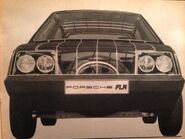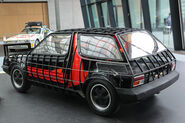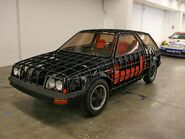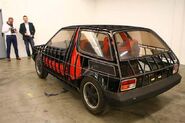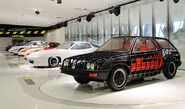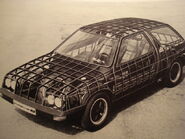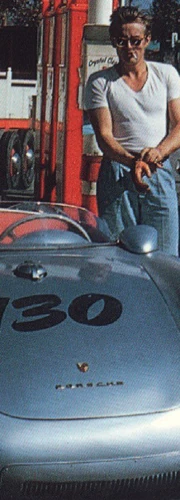| File:Porsche FLA.jpg | |
| Porsche FLA | |
|---|---|
| Porsche | |
| aka | Porsche Long-Life Study |
| Production | 1973 |
| Class | Compact |
| Body Style | Three-door hatchback |
| Length | c. 4000 mm |
| Width | c. 1700 mm |
| Height | c. 2000 mm |
| Wheelbase | c. 2500 mm |
| Weight | c. 1350kg |
| Transmission | Three-speed semi-automatic |
| Engine | 2.5 litre four-stroke, naturally aspirated |
| Power | 75bhp |
| Similar | Volkswagen Golf |
| Designer | Porsche Design Team |
In 1973, Porsche conducted a study into the possibilities of adapting car development to meet changing environmental pressures, after a study made by the 'Club of Rome' which declared that by the 21st Century, the world would not be able to drive cars. Porsche believed that this was a very serious issue - serious enough to devote a large team of designers, engineers and mechanics, as well as a large budget, towards a car which would burn less fuel but be wholly recyclable. The product of this study was the Porsche FLA.
The Idea[]
In 1973, it was calculated that the number of vehicles scrapped every year was 12 million worldwide, and that the average life of a vehicle was 10 years. With this information, Porsche set the team two aims - reduction of wear and tear; and selection of more durable materials.
To increase the life of the FLA, Porsche decided to create a car completely different to the sports cars which the company were famed for - the FLA was to be a low-performance car with staid, hatchback-like styling. Under the skin, the FLA was fitted with a four-stroke Otto-cycle engine, of about 2.5 litre capacity. The power output was 75bhp, delivered at 3,500 rpm, and the unit featured sophisticated internals to encourage longevity and reliability - for example, hydraulic tappets, a highly efficient air and oil filtration system, and an inspired cooling system which allowed the car to reach running temperatures quickly.
Porsche ensured that the gearbox would keep up with the engine in terms of continued performance - it was a semi-automatic three-speed unit, fitted with a wear-proof torque converter. The automatic was chosen to remove the driver from the gear-change experience, thus reducing the possibility of worn clutches and gear cogs, common on manual gearboxes. Large oil reservoirs were fitted to allow generous time periods between gearbox oil changes. The driveshafts linking the engine and transmission were also engineered for maximum longevity - they were anti-corrosion treated and sealed from the elements.
Although the finished concept was not given a body, Porsche had this covered too, and had researched the possibility of using corrosion-free metals and alloys such as aluminium and stainless steel (made from iron, chromium and nickel). Metals were chosen over plastics due to ease of recycling.
The electrics of vehicles were also thought about, and the FLA was fitted with a contact-free ignition system, along with wiring split intop multiple looms to aid replacement or upgrade. Porsche also fitted aluminium piping, instead of copper, again for recycling reasons, along with silver contacts for the plugs.
The Legacy[]
Although time has rendered the initial concept of the FLA irrelevant - consumption of crude oil has become more of an issue than waste cars - Porsche did incorporate a large number of the FLA's features into its range of cars. The range began to feature cars built from corrosion-free metals, or at least metals galvanised to reduce corrosion. The use of plastics and alloys also began to feature on the contemporary Porsche range.
But the FLA had a large influence on the car industry, and encouraged many other manufacturers to develop strategies to increase the lifetime of their products.

